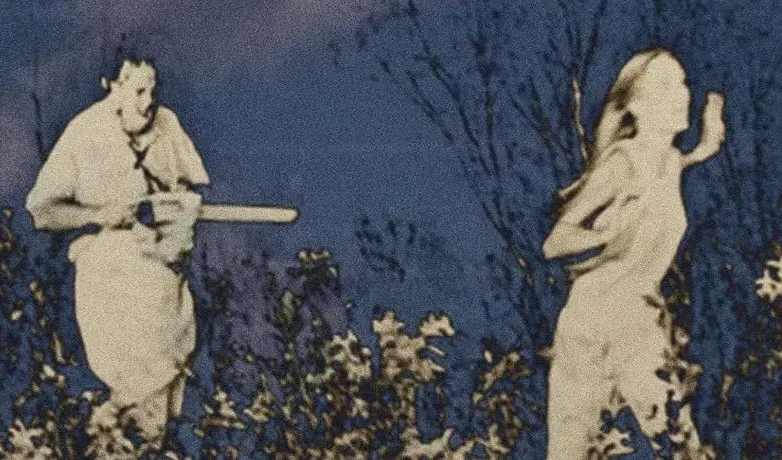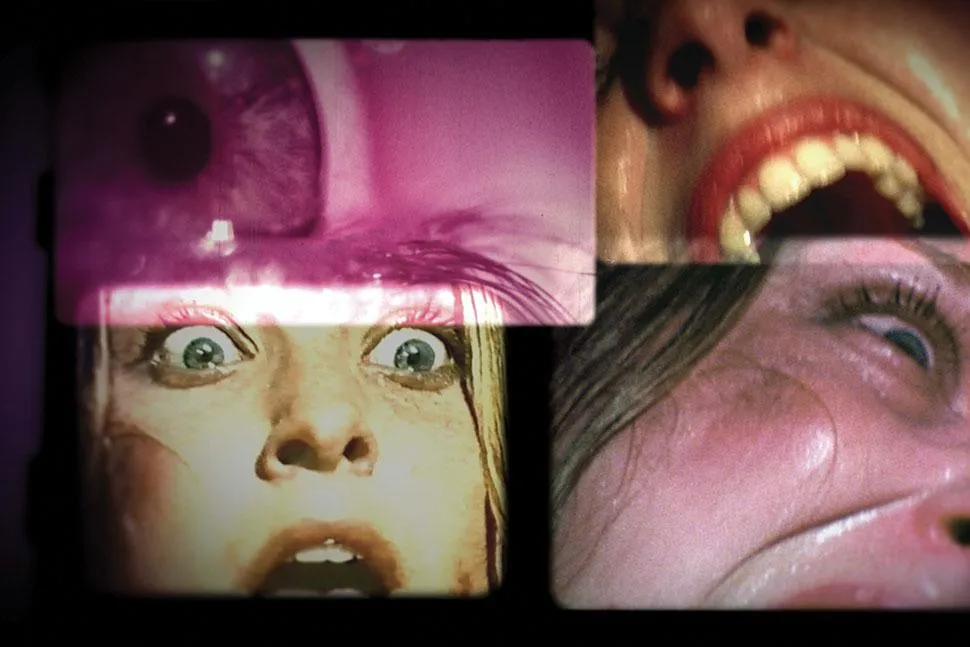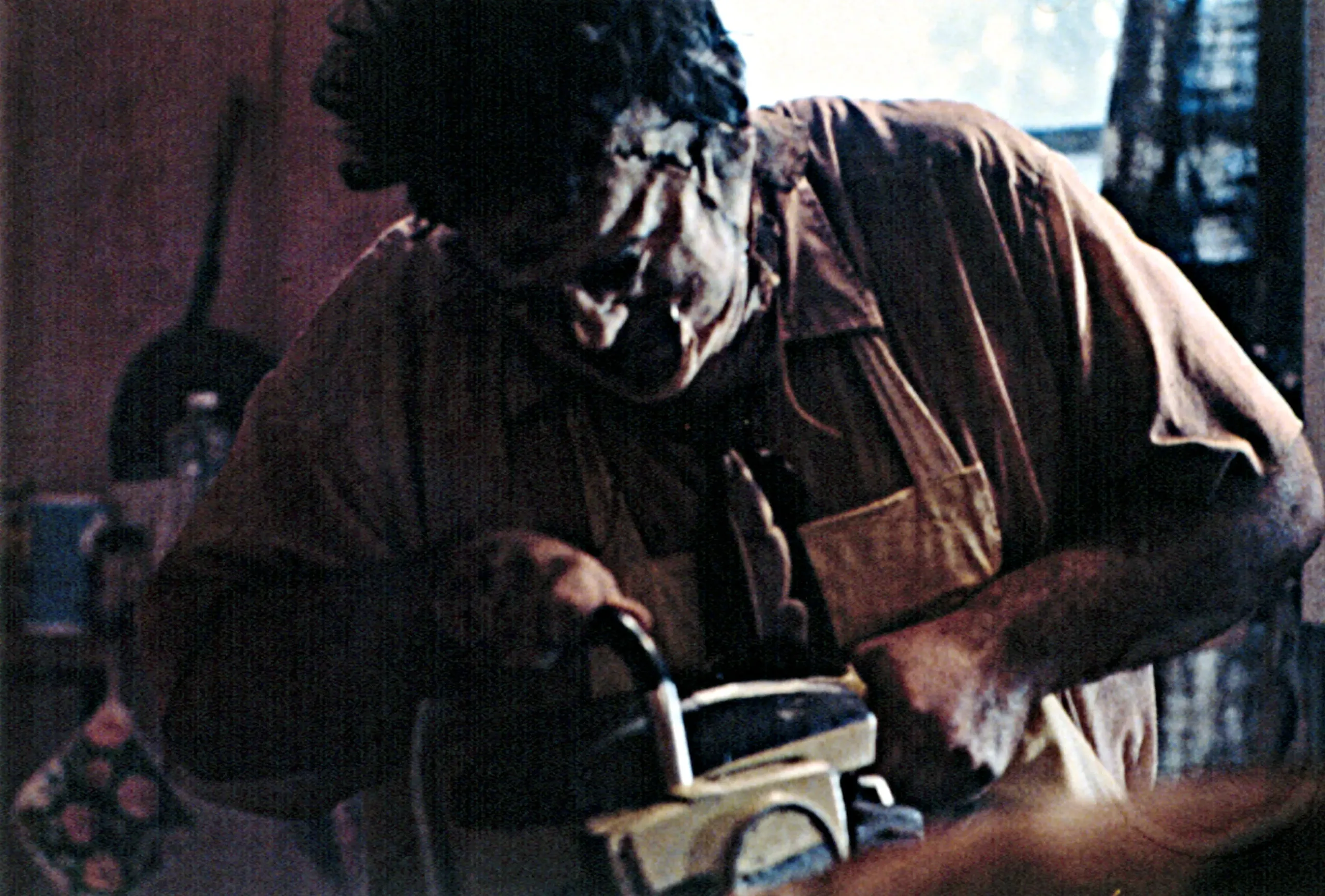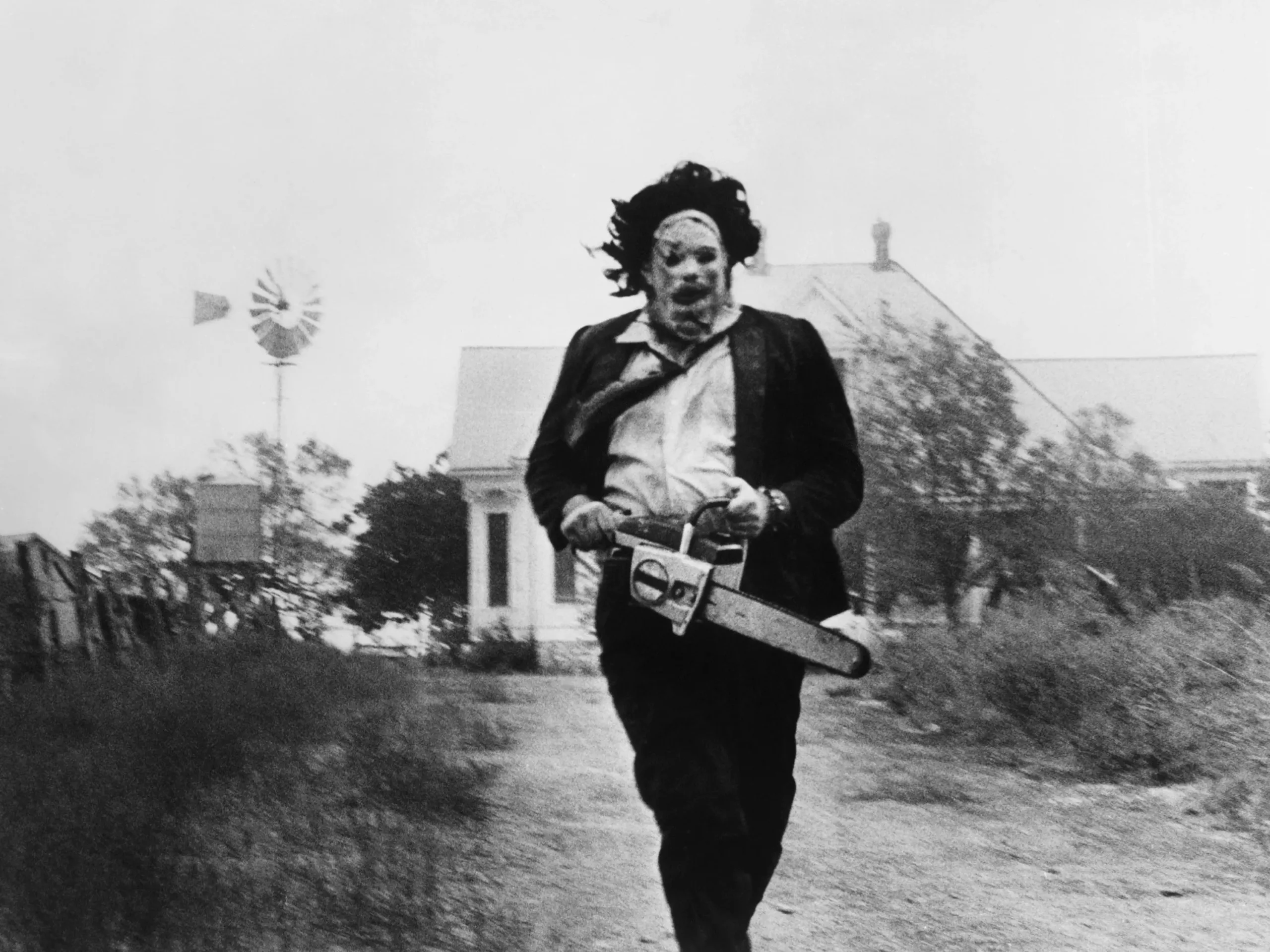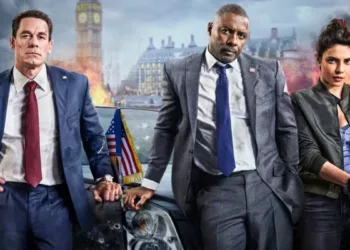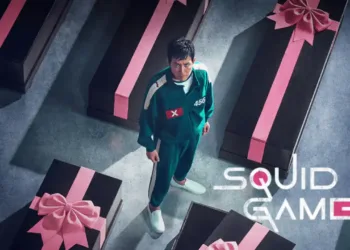Tobe Hooper’s The Texas Chain Saw Massacre (1974) was more than just a horror film; it was a cinematic primal scream that reverberated across post-Vietnam America’s culture. Hooper’s film, released amid a decade when mid-century America’s glossy optimism had given way to disillusionment (Watergate, falling industrial towns, and the oil crisis), depicted a world that felt literally slaughtered.
A new kind of horror was born due to the movie’s dirty atmosphere and unrelenting tension; it didn’t rely on supernatural specters or gothic castles but rather on the terrifyingly banal. Its villains were not Dracula or Frankenstein’s monster, but rather a family of blue-collar sadists who lived in the decaying carcass of the American Dream. Fifty years later, The Texas Chain Saw Massacre is still a genre-defining classic and a frightening reminder of the cultural decay it depicts.
It’s appropriate, then, that Alexandre O. Philippe’s Chain Reactions (2024) isn’t concerned with the mechanics of filmmaking—no boring “how many gallons of fake blood were used” anecdotes here. Instead, Philippe brings together five unique voices (comedian Patton Oswalt, provocateur Takashi Miike, critic Alexandra Heller-Nicholas, horror master Stephen King, and filmmaker Karyn Kusama) to explore the film’s enduring resonance.
Chain Reactions isn’t just a documentary; it’s a séance, summoning the ghosts of Hooper’s vision and investigating the communal psychology that keeps Chainsaw alive in our cultural bloodstream through a mix of interviews, remastered video, and haunting recreations.
Through the Meat Hook: How Five Minds Devour the Chainsaw
It’s a rare film that brings together a comic, a provocateur, a critic, a horror legend, and a contemporary auteur under one blood-soaked flag. But The Texas Chainsaw Massacre isn’t just any film; it’s the cinematic equivalent of raw nerve endings exposed to the elements.
In Chain Reactions, Philippe draws on his interviewees’ personal anecdotes and philosophical ideas to create a kaleidoscopic portrait of the film’s lasting impact. Each artist’s perspective feels like a chapter in a common, horrible mythology, reinterpreting Hooper’s nightmare via their creative lenses.
Patton Oswalt begins with the kind of ironic exuberance that only he can summon. Oswalt, a self-proclaimed cinephile and horror nerd, describes his introduction to Chainsaw as “like being force-fed nihilism” rather than just formative. (You almost hear him say it with a smirk.) He compares Hooper’s Leatherface to early horror cinema’s slow-moving, theatrical creatures, claiming that the film “ripped away the safety net.”
According to Oswalt, the chainsaw becomes a kind of anti-punchline. Whereas comedy develops tension and then releases it with laughter, Hooper builds tension and releases it with a roar of violence. This mentality is one that Oswalt appears to have incorporated into his own work, in which the ludicrous and horrifying frequently clash.
Takashi Miike’s discovery of Chainsaw was a pleasant accident (possibly an unhappy one). After being denied admittance to a City Lights showing, he strolled into Hooper’s rural hellscape—a detour that, in retrospect, feels cosmically purposeful. Miike reflects on the film’s lack of rationale and its unashamed descent into chaos. Chainsaw affected Miike’s work, from the gut-wrenching violence of Audition to the anarchic delight of Ichi the Killer. What’s also noteworthy is his observation that Chainsaw was seen in Japan as a kind of grotesque travelogue—a bleak portrayal of an America “where even the grass feels sharp.”
Meanwhile, Australian reviewer Alexandra Heller-Nicholas provides a personal perspective molded by her first viewing of a grainy, abused VHS video (which she observes almost seemed to sweat). Chainsaw was more than just gore to her; it was also about texture, color, and the eerie interplay of the two.
She discusses how the film’s yellow and red palette echoed the visual language of Australian cinema, particularly Wake in Fright’s sun-scorched terror. The cultural parallels are striking: both films exploit remoteness and desert locations to examine societal collapse, albeit with kangaroos rather than cannibalistic rednecks.
Stephen King’s reflections, naturally, tend toward the metaphysical. He describes Chainsaw as a work of “pure terror” and a kind of cosmic joke in which the universe’s punchline is that evil does not require a reason to exist. King’s musings are somewhat fragmented (he briefly veers into The Evil Dead area). Still, his core premise is clear: Hooper’s film revolutionized horror rather than just depicted it. Chainsaw illustrates a turn from the Gothic to the grotesque for King, influencing his investigations of the horrific in works like It and Pet Sematary.
Finally, Karyn Kusama brings the subject up to date, looking at Chainsaw not just as a product of its time but as a timeless investigation of fragmented masculinity. She sees the Sawyer family as a grotesque reflection of the nuclear family, their violence motivated by desperation and impotence.
Kusama’s thoughts are among the most moving in the documentary, especially her observation that Leatherface’s last chaotic chainsaw dance feels like “an attempt to kill the sun itself.” It’s a moment that goes beyond horror, almost mythic—a picture of wrath and futility that speaks to every generation’s concerns.
Philippe’s decision to present these insights as a cross-cultural and disciplinary discussion is inspired. Each voice adds a new layer to the film’s legacy, revealing that The Texas Chain Saw Massacre is as much about the audience as it is about the film—a dark, unforgiving mirror into which we can’t help but stare.
Buzz Saw Aesthetics: How Chainsaw Cut Through Cinema
There are horror films that scare, and horror films that rewrite the genre’s DNA. The Texas Chain Saw Massacre falls squarely into the latter category, a seminal work that shattered the cozy Gothic traditions of preceding decades (think Dracula or The Haunting) into a jagged, nerve-racking experience. Its impact on the horror genre is so widespread that it is almost invisible—you don’t notice the oxygen you inhale until it’s gone.
Consider the slasher genre, for example. While Leatherface may not be as well-known as Michael Myers or Jason Voorhees, his towering, human-but-not-quite presence helped lay the basis for them. John Carpenter’s Halloween (1978) is influenced by Hooper’s relentless pace and voyeuristic camerawork. Wes Craven’s The Hills Have Eyes (1977) has a dirty, gloomy atmosphere that feels stolen from the Sawyer family home. Even films that seem to be in a different world, like Ari Aster’s Hereditary (2018), mirror Chainsaw’s dedication to stark, smothering fear. And don’t forget Takashi Miike’s wonderfully grotesque Audition, which appears to ask, “What if Leatherface had a day job and a penchant for sadistic performance art?”
However, Chainsaw’s Chainsaw did more than just carve out a place in horror; it also pushed the bounds of cinema itself. Its grungy, low-budget look (those grainy 16mm pictures smelled like sweat and decay) became a visual bible for small filmmakers.
The handheld immediacy of The Blair Witch Project (1999) and the DIY spirit of early Robert Rodriguez films (El Mariachi, anyone?) bear witness to this DNA. Even outside of horror, film directors like Quentin Tarantino have praised Hooper’s work as a masterclass in establishing tension through sound and picture.
The film’s subtext—a dismal rumination on societal deterioration in post-Vietnam America—crosses genres, influencing slow-burn dramas and austere character studies. In this sense, The Texas Chain Saw Massacre may be considered a cultural relic rather than a horror film: a warning, sorrow, or scream.
Meat Hooks and Malaise: The Cultural Dissection of Chainsaw
The 1970s were a decade of disillusionment. The optimism of the postwar era had become sour, with the Vietnam War, Watergate, and the oil crisis causing significant cracks in the American psyche.
The country was no longer the land of white picket fences and glistening Cadillacs; it was where manufacturing rusted, cities crumbled, and dinner tables became increasingly empty by the day. The Texas Chain Saw Massacre erupted against this backdrop like a wild scream, catching the rot beneath the surface of Middle America with grotesque clarity.
Though purportedly about a family of cannibalistic killers, Hooper’s film works as a portrait of society’s disintegration. The Sawyers are a grotesque satire of blue-collar America—former slaughterhouse workers (notice the repeated references to industrial ways of killing) who have been abandoned by modernity.
Their violence is both horrific and weirdly pitiful, a desperate attempt to maintain relevance in a world that has abandoned them. Chainsaw is more than just a horror film; it is a requiem for the working class. (Replace the chainsaw with a foreclosure note, and the metaphor almost writes itself.)
The themes of consumption and exploitation are much more relevant today. Leatherface’s victims are not just slain; they are processed and reduced to flesh. The sneaky remark on capitalism and the monetization of human life is impossible to ignore. Decades later, in an era of factory farming and true crime as entertainment, the film’s relentless efficiency is unsettlingly current.
However, despite its meaning, Chainsaw never feels sanctimonious. Its power stems from its refusal to explain itself. The film is a nightmare, not a lecture, and its themes emerge naturally, like blood pouring through a bandage. Whether it’s a statement on the demise of the American Dream or merely a fever dream of fear, one thing is certain: Hooper held up a mirror to the 1970s, and what appeared was Leatherface.
Sawdust and Shadowplay: Crafting Carnage on a Budget
What sets The Texas Chain Saw Massacre apart from its horror contemporaries is not just its material but also its craft—an alchemy of technological restrictions and raw ingenuity that transformed a shoestring budget into a cinematic nightmare. Daniel Pearl’s cinematography is a masterclass in low-budget inventiveness.
Shot on 16mm film, the grainy texture gives the movie an almost documentary-age urgency, as if we’ve stumbled onto an archival video of something we weren’t supposed to witness. The classic tracking picture of Pam strolling approaching the Sawyer house, her back drenched in sunlight, is both beautiful and haunting—a visual sucker punch that draws us into the butcher with pastoral calm.
Then there’s the sound design, which could be the film’s most unsettling aspect. Forget over-orchestrated stingers and melodramatic violins; the score here is a cacophony of metallic screeches, animalistic grunts, and the frightening buzz of a chainsaw.
It’s less music and more sonic violence, intended to shake your bones rather than simply set the tone. Combined with Hooper’s frenzied editing (which appears to imitate the characters’ distress), the sensory overload traps spectators in the film’s oppressive atmosphere.
These inventions did more than just define Chainsaw; they also redefined horror. The film’s DIY mentality laid the groundwork for The Blair Witch Project’s handheld pandemonium and Paranormal Activity’s lo-fi dread. Meanwhile, its atmosphere is reminiscent of films like Hereditary, which feature persistent noise. Hooper weaponized the medium itself, not just made a horror movie.
From Blood to Legacy: The Chainsaw Echoes On
Fifty years later, The Texas Chain Saw Massacre is more than just a film; it is a cultural scar tissue that cannot be ignored. Its continuing influence on cinema resembles a jagged fault line, splitting the genre into new and darker areas.
Hooper’s vision did more than just question horror norms; it demolished them with the same ruthless efficiency as Leatherface using his titular weapon. From the rise of the slasher genre to the psychological trauma of modern horror, Chainsaw has served as an evil blueprint for anybody willing to explore the thin line between survival and destruction.
But Chain Reactions’ brilliance lies in its ability to explain why this film is still relevant. Philippe’s documentary does more than just review the film’s history; it reframes it through its collaborators’ deeply personal and often eccentric glasses. Patton Oswalt’s hilarious analysis, Takashi Miike’s chance encounter, and Alexandra Heller-Nicholas’ VHS-fueled nostalgia all point to one thing: Chainsaw isn’t just seen; it’s consumed, processed, and remade.
Chain Reactions demonstrates that horror is more than just fear—it is about reflection. The film’s legacy is less about its gore than its ability to linger, like the sound of a chainsaw churning in the distance, foreshadowing catastrophe.
The Review
Chain Reactions
The Texas Chain Saw Massacre is an unflinching exploration of societal deterioration, fear, and the grotesque, cementing its place as one of cinema's most significant horror films. Alexandre O. Philippe's Chain Reactions builds on this legacy by exploring its cultural ramifications through personal observations, philosophical speculations, and creative critique. While occasionally repetitive, the documentary captures the unsettling persistence of Hooper's masterwork, reminding us why it is still terrifying and inspiring five decades later.
PROS
- Groundbreaking sound design that heightens the tension and dread.
- Gritty, documentary-like cinematography that immerses viewers in its horrifying reality.
- Subversive themes exploring societal decay, capitalism, and fractured masculinity.
- Enduring influence on both the horror genre and broader cinematic storytelling.
- Memorable characters, particularly Leatherface, as a symbol of primal fear.
CONS
- Relentless intensity may alienate casual viewers.
- Limited character development for the protagonists.
- Some pacing issues in quieter moments.








































